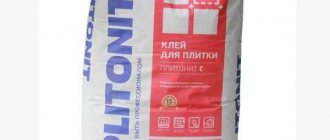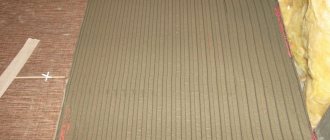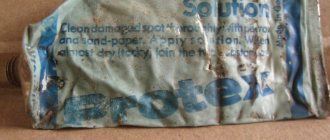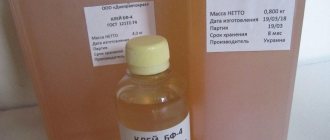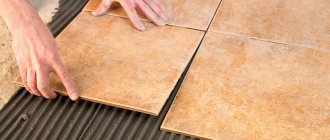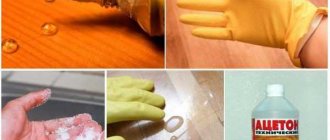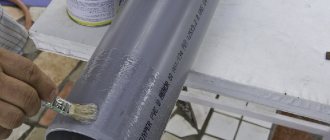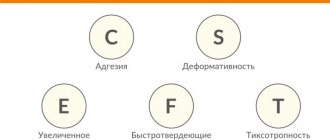Plitonit is a tile adhesive that is intended for the installation of ceramics, porcelain stoneware, and clinker slabs. It provides good adhesion to any substrate. Thanks to its high elasticity, it reliably fixes the cladding on both horizontal and vertical planes. Available in the form of a gray dry powder mixture. Packaged in paper packaging of 5 and 25 kg. Before use, dilute with water in accordance with the recommendations in the instructions.
Specifications
Plitonit tile adhesive is used for laying ceramic, porcelain stoneware, clinker slabs on horizontal and vertical planes with any base.
Technical characteristics of Plitonit:
- Plitonite is produced in three series: a, b, c. Packaging is carried out in bags of 5 and 25 kg.
- The contents of the bags are a dry, gray powdery mixture. To prepare the solution, you need to dilute the powder with water according to the instructions.
- The mixture contains cement, binders, adhesive components, modifiers, and fillers.
- Powder grains no more than 0.63 mm.
- The finished solution is plastic, which makes it possible to hold the tiles on a vertical area without slipping.
- It is permissible to form a glue joint up to 10 mm.
- Commissioning of the tile cover is permissible no earlier than one day later.
- Temperature conditions when applying the layer are 5–30 degrees, during operation – +60 degrees.
- Adjustment of the tile layer is permissible within 15 minutes; the finished solution requires consumption within 4 hours. After the expiration date, the mass will lose its properties and will not provide the required adhesion.
- Service life 12 months.
View this publication on Instagram
Publication from SKS Construction Trading House (@std_sks_spb) July 23, 2022 at 5:34 PDT
Kinds
- "Plitonite A". Universal tile adhesive, for any facing materials with a moisture absorption of at least 1%. Reliably fixes the tiles on a horizontal base and prevents the tiles from sliding off vertical and inclined surfaces. Elastic, moisture-resistant composition. Suitable for heated floors.
- "Plitonite B" It is used when laying ceramic tiles and porcelain stoneware on gypsum, concrete, and brick bases. Has increased frost resistance.
- "Plitonit B+". The adhesive has increased moisture resistance, so it can be used in damp areas (baths, saunas, bathrooms, swimming pools). Resistance to low temperatures (frost resistance) allows use for facade work. Suitable for working with vertical surfaces.
- "Plitonit Express Wb". Improved version of Plitonit B glue. You can grout the seams within 2 hours after laying the tiles. Suitable for urgent installation. Frost-resistant, adheres to any base.
- "Plitonit In Maxislayer". You can glue large-sized, relief slabs and stone blocks. Can be applied in layers up to 3 cm, while leveling the base. Has high plasticity and increased adhesion. Suitable for application on terraces, balconies, and for façade cladding.
- "Plitonit In Clinker". Reliable product for laying clinker and stone. Does not shrink.
- "Plitonit B Pro". Professional product for complex styling. They glue mosaics and use them in finishing plinths, balconies, terraces, and facades. Suitable for brick and plaster bases, as well as for installing tiles on cellular concrete and tongue-and-groove slabs.
- "Plitonit in Superfloor". Floor finishing composition. It has a cement base. Fills small and medium-sized air chambers and levels the base.
- "Plitonit Superfireplace Thermal glue." It is used for lining stoves, fireplaces and other heated surfaces with different types of tiles. You can rub heated surfaces. Operational t=+150 °C.
- "Plitonit S". Assembly adhesive for working with complex substrates - old ceramics, paint, surfaces with residues of another adhesive. Has low consumption. Plitonit S adhesive is intended for use outside buildings and in swimming pools.
- "Plitonite S Marble". Marble cladding, glass, mosaic are installed. The seam turns out white, the color does not change over time. The composition is moisture resistant and requires 8 hours to completely harden. Suitable for use in swimming pools and for heated floors.
- "Plitonit Aqua Barrier" and "Hydro Glue". Mixture for treating areas that come into contact with water. Very flexible, resistant to chlorine-containing liquids. Can be used in places in contact with drinking water.
- "Plitonit Wallpaper Classic". Wallpaper gluing agent. The composition is improved by the cellulose included in it. Provides high bonding strength. Has antiseptic characteristics. Eco-friendly before and after drying. Has low consumption.
- "Plitonit Color Fast Premium". Two-component grout for final sealing of joints. Prevents their contamination and moisture seepage. Designed for damp areas. Prevents the development of mold and fungi. Does not contain pigment.
Advantages and disadvantages
Among the advantages of using plitonite adhesive mass, the following are highlighted:
- The solution does not require special preparation; the dry mixture mixes well in water without forming lumps.
- Increased adhesion.
- Low level of slip coefficient from the vertical plane.
- The flexibility of the layer allows you to hold the tiles, preventing cracking when the building shrinks.
- Moisture and frost resistance allows work to be carried out from the street side.
- Availability.
Negative points include:
- The base must be carefully prepared before laying, otherwise the tile layer will move away from the surface.
- The minimum packaging is 5 kg, so you will have to overpay for an unnecessary amount of glue.
Advantages
- Convenient release form. The dry mixture is easy to dilute and knead, almost immediately you get an even, homogeneous solution without lumps.
- Good adhesion characteristics. The mixture reliably fixes the cladding on any base. For the installation of large-sized tiles, a reinforced compound is used that can hold heavy cladding.
- Elasticity. The characteristic is especially important for work in new houses that are subject to shrinkage, and where the tiles will be subject to increased dynamic loads.
- Moisture resistance. All types of glue are resistant to moisture. But some species are more moisture resistant. Such compositions are suitable for cladding in swimming pools, installing tiles on paths and porches.
- Low temperature resistance. Most Plitonit brand adhesives can be used for interior and exterior use. Can withstand several freeze/thaw cycles. The thawed glue line does not crack or crumble.
- High wear resistance. The adhesive joint lasts a long time, as does the tile placed on it. The most durable and wear-resistant compounds of the C series.
- Wide application. The mixture can be used to glue tiles, porcelain tiles, there are types for installing mosaics, marble, stone, and large tiles. The bases can also be anything: plaster, putty, concrete, brick, old cladding.
- Ease of use. The ready-made solution is easy to apply and installation of the cladding takes little time. Plitonit dries quickly; some types of glue allow you to start grouting joints within a few hours.
Preparation of mortar mixture
The condition for preparing the solution is room temperature of the driest mixture of plytonite and water. If the bag was stored or purchased in cool weather, then before use it should be kept warm for up to two hours.
The solution is made from purified water without chemical compounds, which is poured into a container with a cleaned bottom and walls. It is forbidden to knead in a dirty container or with dirty tools. If a construction mixer is used, then the attachment is new or cleaned from the previous batch.
According to the instructions, for one kilogram of dry Plitonit glue you need 240 ml of water. That is, approximately 6 liters of water are consumed for a 25 kg bag.
Initially, water is poured, and then the dry mixture is poured.
To check whether the solution has been prepared correctly, apply it to the wall; if there is no dripping, then the consistency is correct. The stirred mixture is left for 5 minutes to swell, then mixed again. Throughout the work, the mixture must undergo additional mixing.
Useful video on the topic:
How to use
When working with the mixture, the conditions must comply with the manufacturer's requirements. Operating temperature should be within +5…+30. Under the same conditions, the laid tiles are dried for 72 hours after. You can start grouting joints and using the laminated floors and walls no earlier than 24 hours after completion of the work.
Preparing for work
First, the condition of the facing material is assessed. There should be no dirt, grease or dust on it, which would impair adhesion. The tiles are thoroughly cleaned and dried to remove any contamination. There is no need to soak the tiles before laying.
Next, the base is prepared.
The surface must be strong, smooth, without significant differences. Any deformations, falling parts and fragments will lead to the cladding quickly falling off.
If there are defects, the base is processed as follows:
- cracks and cracks are puttied and sanded;
- the surface is cleaned of dirt, grease, dust, degreased;
- porous bases are primed in 1-3 layers;
- plasterboard bases are primed with compounds of a similar brand containing antiseptics and fungicides;
- floors are treated with antifungal agents, especially carefully in damp rooms.
Preparing the mixture
Plitonit glue is prepared from ingredients at room temperature. The dry composition brought from the street should lie in a warm place for a couple of hours. To dilute the solution, use only clean buckets and tools (construction mixer or drill with a mixing attachment). Dirty equipment with remnants of other mixtures will cause deterioration in the quality of tile adhesive.
It is better to dilute the dry mixture with drinking water, which, unlike technical water, does not contain foreign impurities. For 1 kg of powder composition, take 240 ml of water, that is, for a bag weighing 25 kg you need about 6 liters. The sequence for mixing glue is as follows:
- water is poured into a clean bucket;
- dry powder is poured with a trowel;
- the solution is mixed with a construction mixer until homogeneous without lumps;
- the finished mixture settles for 5 minutes. and mixes again.
The consistency of the glue is correct if, after application to the wall, the layer does not begin to slide down or fall off. The prepared glue must be stirred periodically.
Subtleties of application
- It is better to apply the glue with a smooth spatula, but to improve adhesion to the base, it is then recommended to give the layer a comb shape using a serrated tool.
- The mixture is applied only to a small area at a time, since a large area dries out quickly and a dense crust forms on it. It needs to be removed, or even better, the solution must be completely replaced.
- When a tile is placed on a layer of glue, you need to carefully make turning movements with it, simultaneously pressing each element into the mixture.
- To maintain the correct width of the tile joints, crosses or SVP (tile leveling system) are placed between the laid fragments of the cladding.
- The evenness of the laying of the fragments is checked with a laser level, if necessary within 20 minutes. After installation, the position is corrected.
- Excess glue is removed with a metal spatula or knife until it hardens.
- The front part of the tile is wiped off from adhesive residues with a damp sponge or rag.
- To prevent the formation of air chambers when laying large-sized cladding, it is better to apply the adhesive using a combined method - on the back of the tile and on the base. Please note that this installation method increases glue consumption by 1.2 kg/sq.m.
- The glue will dry for a day, during which the pasted surface cannot be used, otherwise the tile may move or peel off completely.
- It is possible to exert physical stress on the surface only 72 hours after gluing.
- Warm floors can be turned on a week after installation.
- To speed up the drying of the solution, you need to ensure uniform air heating in the room.
- It is necessary to prepare the amount of solution that is needed for work, since the dried mixture cannot be re-diluted. The remaining powder remains in a tightly closed package.
- When working with Plitonit, especially when mixing, use personal protective equipment. To prevent the powder from getting into the respiratory tract and mucous membranes, wear a respirator and goggles. The skin of the hands is protected with gloves. In case of accidental contact with the skin, the mixture is immediately washed off with plenty of water.
Work order
The work is carried out under the conditions prescribed by the manufacturer (at a temperature of 5–30 degrees), then the layer will dry evenly, ensuring complete adhesion. Put the tiled surface into operation no earlier than one day after installation. This also applies to grouting work.
The tile material is completely cleaned from the working side. The coating that is covered with tiles should not contain unevenness, old material, deformation is excluded.
The surface is puttied to remove cracks and crevices, then primed. It is advisable to buy the primer of the same brand as the adhesive mixture. If the room is damp, then the primer should contain antiseptics and antifungal components.
Description and distinctive features of the adhesive composition “Plitonit”
The glue is produced in the form of a dry construction mixture in boxes or bags with a capacity of 5.25 kilograms. Ceramic tiles and the surfaces on which they are attached differ in composition and properties, so the line contains products for various purposes. The correct choice of product is the basis for reliable and durable operation of the tile covering.
Features of Plitonit adhesives:
- pronounced adhesive properties;
- moisture resistance;
- durability;
- plastic.
The compositions reliably fix ceramics on vertical walls, hold heavy materials, and do not collapse under the influence of high temperatures and high humidity. Adhesives are intended for home and professional use when performing construction and repair work.
The production of Plitonit adhesives was launched in 3 series – “A”, “B”, “C”. Products for porcelain tiles, fireplaces, and universal glue are produced separately. Within the series there are products with enhanced adhesiveness and strength characteristics within the stated areas of application.
Subtleties of application
When working, there are subtleties that should be taken into account:
- The adhesive is spread on the tiles using a notched trowel.
- You should not apply the adhesive mixture directly to a large surface area, as the formation of a dry film will reduce the quality of adhesion.
- The same distance must be maintained between the tiles (crosses must be placed); adjustments to the location are carried out within 20 minutes.
- Excess should be removed immediately after adjustment to avoid later scraping from the face of the tile.
- When laying large tiles or on a “warm floor” system, the application is combined, the solution is applied to the tile and the main surface.
- Use is prohibited within 24 hours after installation.
- The work is carried out subject to the availability of IZ funds.
- If the solution gets on exposed skin or mucous membranes, rinse with running water.
Interesting video on the topic:
Consumption rates
The average consumption of the Plitonit mixture per 1 m2 is 1.7-5 kg.
A number of factors influence the consumption rate.
- Tile size. The larger it is, the thicker the layer of glue required.
- Tile material. Ceramics absorb less solution than tiles.
- The degree of preparedness of the base and evenness. Deformed surfaces require applying a larger layer of solution.
- Application method. Application with a notched trowel is more economical compared to the continuous application method.
- Master's experience. Beginning builders spend more mortar per 1 m2 and apply it in an uneven or too thick layer.
For gluing 1 sq. m. a small tile 10x10 cm will require 1.7 kg of mortar, and a large tile measuring 30x30 cm with seams of 2-3 mm will require up to 5 kg/m2.
To calculate the required volume of the mixture, multiply the consumption by the area of the base to be pasted.
Purpose and application features
Before starting work, you need to evaluate the operating features, properties of the base and select the appropriate product from the proposed line of products. Features of the use of different products in the line:
- “Plitonit A” is used as a base material for masonry on vertical and horizontal bases in interior work. The glue is moisture resistant.
- “Plitonit B”, “B+” are used for fastening artificial and natural stone, clinker ceramics, and porcelain stoneware. Used for heated floors, swimming pools, facades, walls. “B+” is frost-resistant, with increased adhesiveness.
- "Plitonit B6" ("Express"). Used for indoor and outdoor work. Glues all types of tiles to walls and floors made of concrete and various types of plasters. Resistant to water, low and high temperatures.
- "Plitonite B Maxislayer." A special product for gluing large, heavy, embossed tiles with the ability to work “from top to bottom”.
- "Plitonite B Clinker". Used for fastening clinker tiles and stones indoors and outdoors. It is allowed to use a layer of glue of different thicknesses.
- “Plitonit V Superpol” is a grout-adhesive for floor work, leveling the surface and sealing joints. The base is cement.
- "Plitonit V PRO". For finishing plinths, terraces, balconies, rooms with significant traffic, cladding ceilings with mosaic tiles in dark shades.
- "Super Fireplace OgneUpor." The composition contains heat-resistant fibers, which allows the use of glue for stoves, chimneys, and fireplace masonry.
- "AquaBarrier". The composition is intended for lining water tanks and is resistant to water and bleach.
- "Accelerated". Universal product for floor coverings.
- "Plitonit S". Adhesive for complex surfaces - with old coating that has not been removed (tiles, paint, adhesive mixtures). Universal adhesive for pools, floors, walls.
- "Plitonite S Marble". For fixing large-format marble tiles and mosaics. The composition includes components that protect against the formation of limescale and efflorescence.
When choosing glue, you should read the attached instructions and do not neglect the manufacturer’s recommendations. Particular attention is paid to maintaining the temperature regime, treating the surface for gluing, applying and distributing the required amount of adhesive.
See also
Technical characteristics and instructions for use of Hercules glue
For work, you should purchase special spatulas (notched, smooth), which will facilitate application and reduce the consumption of the composition.
Nuances of use
This product is applied with a special tool - a spatula with teeth or a smooth spatula.
Experts apply glue using the latter. But then they make a wavy structure, so the glue glues the tile and the base even better. It is also not recommended to cover a large base with glue at once, since it quickly sets into a crust, which will have to be removed and then applied with new glue.
Here are some subtleties of working with the tool:
- After the glue has been applied, a tile is placed on it and pressed into the product with gentle turning movements, pressing on certain elements;
- To ensure that the seam between the tiles is the same, special plastic crosses are placed between the tiles;
- If it is necessary to adjust some tiles, this can be done within 20 minutes, sometimes a special level is used;
- Excess solution must be removed immediately before it dries. This is done using a metal spatula or a knife;
- The tile itself is cleaned of the product using a damp cloth.
If the material is laid on a warm floor or large tiles are laid, then a void may form between the material and the surface. In this case, the solution is applied not only to the base, but also to the tile itself.
And so that the layer of glue does not turn out to be very thick, it is applied using a spatula with teeth. If you need to level it later, this can be done with a special smooth object. It is important to wait until the solution on the floor dries completely - this is a day.
If the glue has not had time to dry completely, then the tile may move under pressure, and if the layer of glue was not thick, then the tile may even move away from the surface. Any serious impact on the floor should not be done within three days, for example, moving furniture.
If there is a heated floor, then it cannot be used for a week after laying the tiles.
And if you organize warm air in the room, this will help the solution dry faster. When working with this glue, a person must use protective equipment.
Especially when the adhesive solution is just being prepared. To prevent the powder from getting into the lungs and eyes, use special glasses and a mask - a respirator. Gloves are used for hands. If the solution does get on the skin, you should immediately rinse the area with water.
Preparatory work
At the very beginning, you need to inspect the condition of the tiles.
If there is dirt, dust or grease on it, the level of adhesion will be low. Therefore, the tiles must be thoroughly cleaned and dried. Next, you need to check the surface, it should be strong, without any unnecessary elements that could fall off.
Otherwise, in such places the tiles may not adhere well. Also, the surface must be level, without holes, depressions and other defects.
Other tips for preparing your base:
- All defects must be covered with putty, and then walked over them with sandpaper;
- Completely remove all contaminants, degrease well with special products;
- The porous base must be primed;
- If the base is made of plasterboard, then it is better to use a primer with antiseptic qualities;
- Floors must be treated with antifungal agents, especially if they are located in areas with high humidity.
